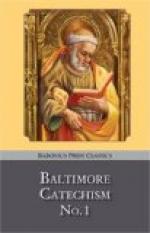296 Q. Why do we make the Sign of the Cross? A. We make the Sign of the Cross to show that we are Christians and to profess our belief in the chief mysteries of our religion.
The cross is the banner or standard of Christianity, just as the stars and stripes—the flag of the United States—is our civil standard, and shows to what nation we belong.
297 Q. How is the Sign of the Cross a profession of faith in the chief mysteries of our religion? A. The Sign of the Cross is a profession of faith in the chief mysteries of our religion because it expresses the mysteries of the Unity and Trinity of God and of the Incarnation and death of Our Lord.
298 Q. How does the Sign of the Cross express the mystery of the Unity and Trinity of God? A. The words: “In the name” express the Unity of God; the words that follow, “of the Father, and of the Son, and of the Holy Ghost” express the mystery of the Trinity.
299 Q. How does the Sign of the Cross express the mystery of the Incarnation and death of Our Lord? A. The Sign of the Cross expresses the mystery of the Incarnation by reminding us that the Son of God, having become man, suffered death on the Cross.
Besides these chief mysteries, we will find, if we think a little, that the Sign of the Cross reminds us of many other things. It reminds us of the sin of our first parents, which made the Cross necessary; it reminds us of the hatred God bears to sin, when such sufferings were endured to make satisfaction for it; it reminds us of Christ’s love, etc.
300 Q. What other sacramental is in very frequent use? A. Another sacramental in very frequent use is holy water.
301 Q. What is, holy water? A. Holy water is water blessed by the priest with solemn prayer to beg God’s blessing on those who use it, and protection from the power of darkness.
The priest prays that those who use this water may not fall into sin; may be free from the power of the devil and from bodily diseases, etc. Therefore when they do use the water they get the benefit of all these prayers, because the priest says: “If they use it, God grant them all these things.”
302 Q. Are there any other sacramentals besides the Sign of the Cross and holy water? A. Besides the Sign of the Cross and holy water there are many other sacramentals, such as blessed candles, ashes, palms, crucifixes, images of the Blessed Virgin and of the saints, rosaries, and scapulars.
“Candles,” blessed on the Feast of the Purification of the Blessed Virgin (see Butler’s Lives of the Saints, Feb. 2, Feast of the Purification). The Church blesses whatever it uses. Some say beautifully that the wax of the candle gathered by the bees from sweet flowers reminds us of Our Lord’s pure, human body, and that the flame reminds us of His divinity. Again, candles about the altar remind us of the angels, those bright spirits ever about




